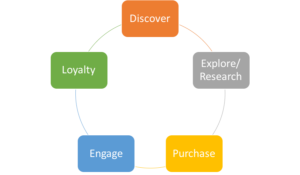Earlier this month, I was researching some running clothing items. I regularly write for a local running themed blog site and was preparing for another gear review article. By this point, my web browser knows full well that I am a passionate runner. Not only that, but my email list subscriptions to running sites runs very deep.
During my travels in research for this article, I visited the site of a brand that I like to buy gear from. I was looking at their running jackets, getting technical information on a product I already own to write the review.
Not 10 minutes later, I visited my personal email inbox. Not to my surprise, I saw an email from this brand in my inbox. What may be surprising, however, is that this email was not marketing the running jackets I was researching. Knowing that I had already purchased that product, they were suggesting other products that would work well in that vein. They were attempting to measure my interest and assess my point in the cycle of their buyer’s journey.
If you’re familiar with the buyer’s journey – the progression a consumer takes in becoming aware of a need or desire, researching options to satisfy that need and deciding on a product to purchase in order to satisfy the need – you know that this linear progression is fast becoming outdated. The traditional buyer’s journey starts with a consumer pain point that needs to be remedied. A need for a product or service to solve a problem in the consumer’s life.
However, in today’s media-constant world, the buyer’s journey has shifted focus. Where once it was consumer-driven, with the consumer in control of when they identify a need, today’s buyer’s journey is intrinsically more brand driven. Brands are in more control of what a consumer sees and when they see it. Digital media, advanced placement tools, and targeting techniques, and a better understanding of where consumers are in their decision-making process has helped this along.
The New Buyer’s Journey
The new buyer’s journey takes the linear journey template and adapts it to today’s media-constant world. Effectively reaching consumers today requires that your brand cuts through the clutter and becomes clear and apparent to your target consumers. Only, the challenge is that today, there are many (many) competing brands looking to do the same thing.\
This means that the buyer’s journey of yesterday, with a large portion of the time and energy spent in the “Prospect” or “Consideration” phase, is rendered obsolete. Not that spending time on your prospects today should go overlooked. But if your brand isn’t generating enough awareness to solve a consumer’s problem, there won’t be enough buyers in your pipeline to worry about.
Instead of a linear stepped approach to attracting consumers, here is what today’s buyer’s journey looks like.

This model more accurately represents the digital consumer world we live in. A buyer’s journey today is much more than finding an entry point on a linear scale. Buyers are able to perform extensive brand and product research wherever they are from smartphones. This means that they may enter an exit a traditional journey multiple times in the course of a buying cycle.
A cyclical approach to the buyer’s journey enables brands to gain information on the consumer, understand their level of interest, and represent opportunities, all within a single sales cycle. Then, once a lead becomes a prospect and a prospect becomes a customer, the new buyer’s journey enhances cross-sell and up-sell efforts to deepen the brand’s relationship with that customer.
While today’s marketing plans have become inherently more complex than those from a time of linear journeys, so too have today’s consumers become more complex. Today’s consumers are expecting that automation and target marketing will bring brands and products to them in order to solve a need based on behaviors. This trait encourages relevancy in messaging and media, but also requires brands to build in appropriate time-to-close for conversion and purchase.


